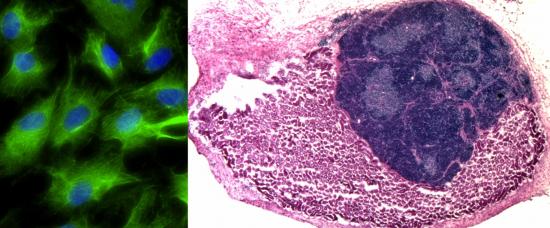
Narcotic drugs could soon be manufactured by yeast
Synthetic biology—the technique of moving genes from creature to creature not one at a time, but by the handful—promises much but has yet to deliver. Someone who believes it can, though, is Christina Smolke of Stanford University. And, as she and her colleagues write in Nature Chemical Biology, they think they now know one way that it might.
Opiates, such as morphine, are widely used as painkillers. Some are extracted directly from opium poppies (paler, as the picture shows, than the sort familiar in Europe and North America), which grow well in places such as Afghanistan and Turkey. Others, such as oxycodone, are chemically derived from natural poppy-molecules. Many of these drugs, though, are also used for recreational purposes—particularly diamorphine, an acetylated version of the principal poppy extract that was branded “Heroin” by its manufacturer, Bayer, in the late 19th century. Since such recreational use is generally illegal, the authorities keep a strict eye on the opium trade, and would no doubt welcome the chance to make that eye even stricter by cutting poppies out of the loop and making diamorphine and its cousins from scratch in facilities they can watch. That, plus the possibility the drugs might be produced more cheaply, has encouraged Dr Smolke to use synthetic biology to see if she can create an alternative source for opiates.
To do so, her team added three crucial poppy genes to some yeast cells. When provided with the appropriate chemical precursor, the modified yeast cranked out morphine and another opiate, codeine. And when one of the poppy genes was itself replaced by two genes from Pseudomonas putida, a soil bacterium, the yeast made oxycodone and hydrocodone too. Though this prototype yeast was not particularly efficient, some further tweaking converted it into a veritable drug factory—capable of cooking up 131mg of opioids (the equivalent of about 26 medical doses of diamorphine) per litre of culture over a four-day manufacturing cycle.
The Latest on: Synthetic biology
[google_news title=”” keyword=”Synthetic biology” num_posts=”10″ blurb_length=”0″ show_thumb=”left”]
via Google News
The Latest on: Synthetic biology
- From ‘shrimp leather’ to synthetic dye, are biomaterials finally ready to scale up?on April 26, 2024 at 12:30 am
However, after at the 10th anniversary of the Biofabricate Summit earlier this year (the densest gathering of bio innovators in the world) it seems that biotech has finally reached maturity.
- Researchers create first artificial, modifiable cells with programmable DNAon April 24, 2024 at 8:08 am
The achievement holds significant promise for advancements in regenerative medicine, drug delivery methods, and diagnostic technologies.
- Self-assembling synthetic cells act like living cells with extra abilitieson April 23, 2024 at 5:00 pm
Blurring the line between artificial and living materials, these cells can be reprogrammed to perform multiple functions, opening the door to new synthetic biology tech that goes beyond nature’s ...
- He Had a Side Hustle Driving for Uber When a Passenger Gave Him $100,000 — Now His Company Is On Track to Solve a Billion-Dollar Problemon April 22, 2024 at 8:45 am
Essentially, enzymes or microbes can be "taught" how to make powerful ingredients — including plant or flower molecules — in a reactor in a lab setting. Continue reading Related: The Future Is...Fungi ...
- China Inaugurates synthetic biology innovation center in Shangahaion April 15, 2024 at 2:13 am
On Sunday, the Shanghai Synthetic Biology Innovation Center was officially unveiled, marking a significant step forward in the promotion of innovatio ...
- Shanghai establishes synthetic biology innovation centeron April 14, 2024 at 10:52 pm
Shanghai attaches great importance to the development of synthetic biology industry. In September 2023, it released an action plan to improve infrastructures, establish new research and development ...
- Seattle biotech research hub launches with big goals for growth, scientific advanceson April 9, 2024 at 5:00 pm
The Seattle Hub for Synthetic Biology celebrated its official launch April 1, and it is already planning for growth. The hub is a joint initiative of the Allen Institute, the University of ...
- Inside the new Seattle Hub for Synthetic Biology, which uses DNA to ‘record biology over time’on April 1, 2024 at 6:20 pm
Scientist Sundarshan Pinglay shows off a liquid handling instrument that automatically dispenses reagents, at the Seattle Hub for Synthetic Biology. (GeekWire Photo / Charlotte Schubert ...
- Synthetic Biology US 2024on March 21, 2024 at 5:00 pm
Don't miss Synthetic Biology US 2024! Join leading omics experts and researchers for a two-day event accelerating the development of synthetic biology tools to enable effective therapeutics ...
- Synthetic Biology Market Projected To Reach USD 96.4 Billion By 2033, With CAGR Of 19.3%on March 12, 2024 at 5:00 pm
According to market.us, it is projected that the global Synthetic Biology Market will witness significant growth, with an anticipated value of approximately USD 96.4 Billion by 2033. This marks a ...
via Bing News










